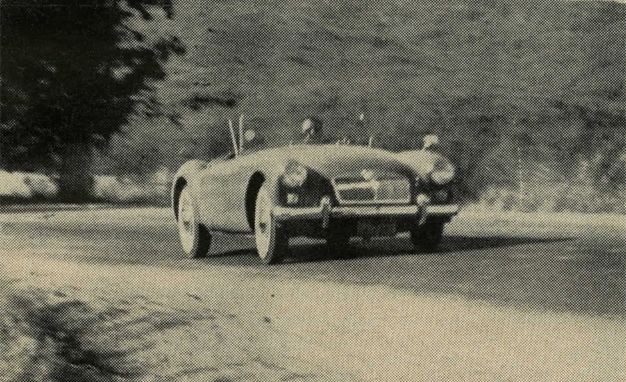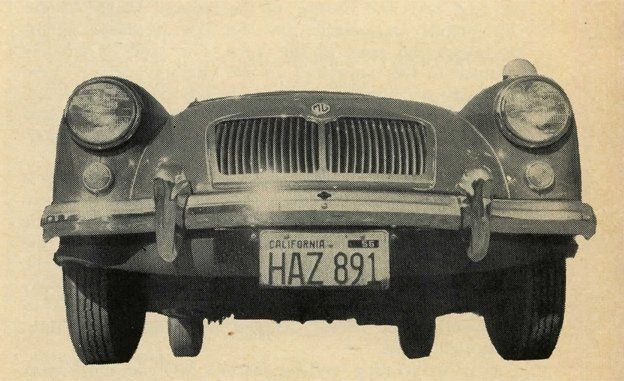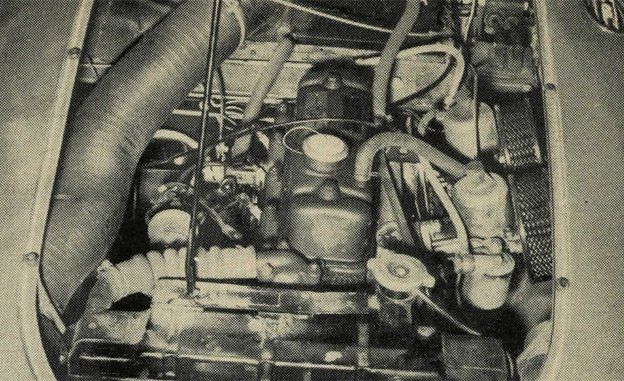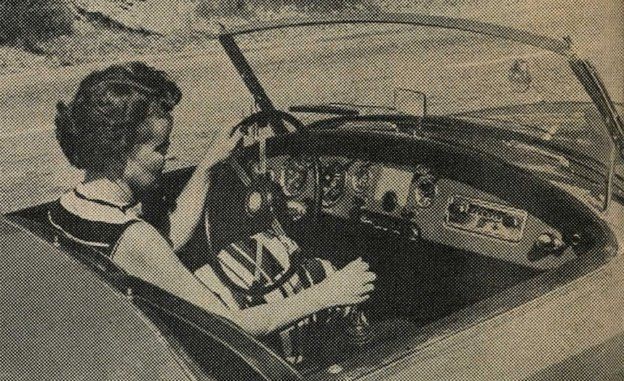The MGA With An Attitude
| MGAguru.com |
|
MGAguru.com |
MG MGA - Car and Driver - Jan'57 - LT-105
|
From Car And Driver magazine, January 1957
MG MGA
A true 100-mph sports car.
By Griff Borgeson
Photos by Car and Driver

The controversial "aerodynamic" MG is a true 100- mph sports car. Our best one-way speed of 101.1 mph was, to be sure, achieved with the help of a gentle zephyr at the rear, but off-setting this is the fact that we reached the full-century speed in only one mile. With a two-mile approach to the measured quarter, undoubtedly, we would have had a few more revs on the tach and a slightly quicker passage through the traps. What counts is that the "A" is an easy 15 mph faster than the TD, 10 mph faster than the TF1500, and stiff competition for such performance rivals as the Alfa Giulietta Sprint and the Porsche 1600 Speedster.
For most of us, nothing induces a friendly, responsive attitude toward a car—a willingness to be prejudiced in its favor—like a modest price. The "A" is a lot of sports car for its base price of $2195. It's almost entirely new mechanically; the only parts interchangeable with the TF are the steering rack and some front suspension components. Its body is sleek and suave and it has perhaps the first really stiff frame in the long evolution of the little hot rods from Abingdon-on-Thames.
But in spite of all the visible and hidden changes and improvements, you have only to drive the "A" around the block to recognize its old MG character. The engineer who designed the TC's noisy tappets, harsh ride, and loud exhaust system is apparently still bending over the drawing board. In spite of its contemporary look, better handling and thrustier performance, the "A" is still pure old-line MG Midget.
Like its ancestors it's a whole lot of fun to drive in spite of—or maybe because of—its imperfections. The steering as always is very quick over a large lock, and Detroit-conditioned drivers look somewhat palsied at the wheel until they sharpen their responses. Once they do, though, the alert steering naturally makes for excellent control of the machine. This steering is light, has a fairly strong self-centering action and is devoid of play. Minor road shocks are not felt through the steering wheel, but big bumps definitely are.

Another of the organs of the machine that retains the old MG's character is the gearbox. The remote shift lever is ideally at hand; stubby and short in travel, and the synchromesh is infallible. Pumping this lever through the cogs on our 5000 mile-old test car still took plenty of bicep power, but we understand that the transmission begins to limber up after seven or eight thousand miles.
The hydraulically-assisted clutch is light, strong and sure and upshifts can be made with lightning speed. Going down from third to second is slightly awkward and presents the possibility of crunching against reverse or even engaging it while moving forward at low speeds. Nevertheless, this is a good and very satisfying gearbox, despite the fact that low gear is overly low.
The "A's" ride is still another instance of blood telling. It's smooth on smooth pavement, and that's all. The rest of the time it's aggressively hard, in the spartan sports car tradition of the Thirties. Unlike a lot of modern light cars, which not only corner well but also absorb horrible bumps, the "A" and its occupants feel every surface ripple. Beyond about 80 or 85 mph, even on smooth pavement, the ride gets a little bouncy—this, in spite of the fact that a prototype of this chassis was run at better than 150 mph on the Bonneville Salt.
But up to this point the car cruises free and easy and still retains pretty good acceleration. It has a solid, substantial, all-of-a-piece feel that's largely due to the "A's" new frame. The big, box-section rails are tied together by cross-members at something like two-foot intervals and to these are added a box-section superstructure that gives added stiffness at the firewall line. This is a heavy frame but a very stiff one, and because of the reduced weight of the "A's" engine, transmission and rear axle, its chassis weighs just about the same as the TF's. The body is securely mounted to the frame and on the roughest surfaces there is no sign of frame twisting or of body panels "working" independently. The doors close with a solid sound and they stay closed, unlike those on some of the springier-framed MG's.

With a full tank of fuel the "A's" weight distribution is very close to 50-50, and this, combined with the stiff suspension and a close tread/wheelbase ratio helps give the car its well-balanced cornering qualities. Its bite in the turns is softer than the on-rails variety, but it sticks to the road very well—much better than its forebears did. Body roll and tire noise are slight. The rear tires begin to slide only when sorely tempted. and then in a slow, controllable way.
As an accelerating machine the new MG goes much more briskly than the TF, in spite of nearly equal displacement and a 1.2 percent reduction in final drive ratio. Since horsepower and torque have gone up just 4.6 and 1.8 percent respectively, most of the gain in both acceleration and top speed has to be caused by the lower wind drag of the "A's" streamlined body. The acceleration curves of the "A" and the TF show that there's a big difference in the way that these similarly endowed cars penetrate the air.
The modified BMC B-type engine is basically the same as the one that powers the four-cylinder Morris, Wolsley and Austin except for its more sporting camshaft and dual carbs. The compact gauze-type air cleaners do little or no silencing and the moan of air being dragged into the cylinders gets really loud at about 70 mph. On the whole this is a pleasant sound, suggestive of gobs of power, but when the weather equipment is up it can get tiresome.
All the porting is on the left side of the engines. There are two intake ports and three for exhaust, feeding into a nicely contoured three-branch "header" type manifold. This style of porting is practically immune to the more advanced forms of intake and exhaust "ram" tuning, but since nobody is more aware of this than the factory, a simple remedy is undoubtedly already on the drawing boards. The throttle linkage is devious.
The throttle pedal is suspended from a shaft that extends to the right-hand side of the firewall. To a bracket on the far end of this shaft is attached a flexible cable that runs parallel to the right-hand side of the engine, then crosses over the top of it to connect with the throttle valves—which actually are no more than a few inches ahead of the foot pedal. Abingdon's engineers could have devised a more direct connection, but this one works very well.
During our warm-weather testing of the "A", the engine always fired up with no hesitation and quickly settled down to a somewhat rough idle at about 900 rpm. The engine revs willingly under load up about 4500 rpm, but at this point the tappets begin to chatter and you can feel the engine starting to work. The four-inch tachometer, now driven by the camshaft rather than the generator, has an orange pie-slice between 5500 and 6000. It also has a red warning slice from 6000 to 7000, but this is mainly decorative. The stock engine is wound very tight at 5500 in the indirect gears and the valve train protests politely but unmistakably. During acceleration runs we hit 5900 on a couple of occasions but retreated in haste. This is just about the limit. To venture into the red area on the tach is to invite the valves to come unglued. But at 5800 rpm in top gear (101.1 mph) the engine, though far from loafing, seems willing to sustain the pace indefinitely.
As it stands, this engine seems to be at the upper limit of its compression ratio. It continues to fire for several revs after the ignition has been cut. But this is the only criticism we have to make of the "A's" power plant. It's a good combination of ruggedness, economy of operation and maintenance, and healthy output.
MG's old motto "Safety Fast" is highly appropriate for the "A". The machine's good steering, roadholding and acceleration are backed up by a set of genuinely outstanding brakes. The ten inch drums are heavy iron castings that show little tendency to expand. The retarding force of the brakes registered the unusual high of .86 g on our instruments, and over the ten-stop fade test they lost only 9.3 percent of their efficiency. (Some cars that Sports Cars Illustrated has tested have had fade losses of 25 percent and more.) From these figures it would seem that the "A's" perforated disc wheels do a good job of brake cooling which can be made still better if you use the optionally available wire wheels. For racing, the factory recommends the harder Ferodo BG95/1 lining, which gives even more fade-proof braking.

The body of the MG "A" is bound to be a controversial subject as long as there are still partisans of the old Thirties-styled models. The TC unquestionably deserves the much abused title of "classic" and the TD and TF proved to a lot of people that it was impossible to get a better looking car by "refining" the crisp, spidery TC.
As it is now, the "A" is a very attractive car from any angle, and downright beautiful from some. Its look and feel of quality, closely approach those of some cars that cost twice as much money. The body feels and is very substantial. The quality of the painted finish is good, there's no skimping on the instrument panel, and the reinforced bumpers are very adequate.
On the negative side, raising or lowering the top is a hassle, luggage space is minute, and the inside door panels are sub-standard compared to the quality of the rest of the machine. The 12-volt electrical system is fed by a pair of six-volt batteries in series, mounted behind the seats but accessible only if you haul the spare tire out of the luggage compartment!
In order to get the "A" 21/2 inches lower than the TF, the frame rails have been bowed out enough to permit the occupants to ride between and alongside them. Sports Cars Illustrated's staff found the semi-reclining seating position perfectly comfortable, but criticized the seat-backs because they support only the shoulders. The driver sits with left leg extended to operate the clutch and right leg cocked to operate the throttle. This turns out to be a comfortable driving position, particularly since the high transmission tunnel provides good support.

On the "A" the headlight dip-switch, which in previous MG's was on the instrument panel, is mounted on the firewall, which is stepped and lies in two planes, the higher portion roughly one foot farther aft than the lower. This means that to operate the switch you have to pull your leg back from its normal, relaxed, clutch-operating position and raise it high enough to prod the switch. Foot pedal room is better in the "A" than in earlier MG's but it's still easy to hook throttle foot on brake pedal, or hit the throttle pedal when you want to brake. This happened to most of our testing crew and made an unforgettable impression; it happened only once per driver.
The air flow around the car at speed with the top down is such that there is very little turbulence in the cockpit—the occupants get little wind buffeting, and conversation in normal tones can be carried on with ease except at high rpm's. With the top up engine noise is magnified, of course. And like most fabric tops the "A" rattles and booms against the wind. The side-screens are well designed, their lower third being a separate panel that can be pivoted outward against a spring-loaded plunger.
But ventilation is either all-off or all-on; there are no openings in the screens to permit the entry of outside air. There are also no external door handles, and reaching in through the spring-loaded flap and down to grasp the door-latch pull-cord can be fairly awkward.
With all its little irritations, this is a basically safe, friendly, likeable car —a genuine, well-built sports machine at a price that can't be considered anything but reasonable and fair. We'd be much surprised if the "A" sales situation were anything but what it is: demand fantastically ahead of supply. It's a very desireable car that will give years of economical driving pleasure and then have the high resale value that MG's have earned.
|